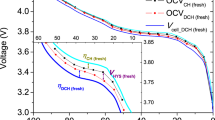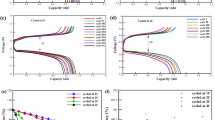Abstract
In this work the self-discharge characteristics are evaluated through resting OCV (open-circuit voltage)-SOC (state-of-charge) hysteresis and storage aging behavior for pouch NCM|graphite lithium-ion battery. A weak peak is found on the OCV-SOC curve of incremental capacity and differential voltage analysis. A low free-energy complex model involving the formation of an absorbed electron-lithium-ion solvation sheath on the graphite surface is proposal for this weak reaction. The electrons are shared between the graphite and electrolyte via lithium-ion. Results of batteries aging tests reveal a strong linear relation of OCV vs. square-root of time, where the dissociation of complex is considered as the mechanism. The dependency of the square-root of time demonstrates that a new concept of voltage drop rate (mV h−1/2) is more feasible by reducing the influence of OCV checking time from 120% to 26%.









Similar content being viewed by others
Abbreviations
- CC:
-
Constant current
- C-rate:
-
Current rate
- CV:
-
Constant voltage
- DVA:
-
Differential voltage analysis
- EVs:
-
Electric vehicles
- ICA:
-
Incremental capacity analysis
- NCM:
-
Lithium–nickel–cobalt-manganese oxide
- OCV:
-
Open-circuit voltage
- SOC:
-
State of charge
- k :
-
Rate of voltage decay (mV h−1)
- OCV1 :
-
OCV of first detection (mV)
- OCV2 :
-
OCV of second detection (mV)
- s :
-
OCV drop rate (mV h−1/2)
- t 1 :
-
Time of first OCV detection (h)
- t 2 :
-
Time of second OCV detection (h)
References
Han X, Lu L, Zheng Y, Feng X, Li Z, Li J, Ouyang M (2019) A review on the key issues of the lithium ion battery degradation among the whole life cycle. eTransportation 1:100005–100025
Barré A, Deguilhem B, Grolleau S, Gérard M, Suard F, Riu D (2013) A review on lithium-ion battery ageing mechanisms and estimations for automotive applications. J Power Sources 241:680–689
Li Z, Huang J, Yann Liaw B, Metzler V, Zhang J (2014) A review of lithium deposition in lithium-ion and lithium metal secondary batteries. J Power Sources 254:168–182
An F, Zhao H, Li P (2018) Self-discharge rates in cells have a critical effect on the cycle life of parallel lithium-ion batteries. RSC Adv 8:30802–30812
Muenzel V, Brazil M, Mareels I, Hoog J de, Thomas DA (2013) Modeling reversible self-discharge in series-connected Li-ion battery cells. In: IEEE 2013 Tencon - Spring, pp 470–474
Zilberman I, Ludwig S, Jossen A (2019) Cell-to-cell variation of calendar aging and reversible self-discharge in 18650 nickel-rich, silicon–graphite lithium-ion cells. Journal of Energy Storage 26:100900–100908
Zilberman I, Sturm J, Jossen A (2019) Reversible self-discharge and calendar aging of 18650 nickel-rich, silicon-graphite lithium-ion cells. J Power Sources 425:217–226
Deutschen T, Gasser S, Schaller M, Siehr J (2018) Modeling the self-discharge by voltage decay of a NMC/graphite lithium-ion cell. Journal of Energy Storage 19:113–119
Redondo-Iglesias E, Venet P, Pelissier S (2018) Global model for self-discharge and capacity fade in lithium-ion batteries based on the generalized Eyring relationship. IEEE Trans Veh Technol 67:104–113
Byun S, Park J, Appiah WA, Ryou M-H, Lee YM (2017) The effects of humidity on the self-discharge properties of Li(Ni1/3Co1/3Mn1/3)O2/graphite and LiCoO2/graphite lithium-ion batteries during storage. RSC Adv 7:10915–10921
Yazami R, Reynier YF (2002) Mechanism of self-discharge in graphite–lithium anode. Electrochim Acta 47:1217–1223
Wang C, Zhang X-w, Appleby AJ, Chen X, Little FE (2002) Self-discharge of secondary lithium-ion graphite anodes. J Power Sources 112:98–104
Sloop SE, Kerr JB, Kinoshita K (2003) The role of Li-ion battery electrolyte reactivity in performance decline and self-discharge. J Power Sources 119–121:330–337
Reynier Y, Yazami R, Fultz B (2002) Thermodynamics and kinetics of self-discharge in graphite-lithium electrodes. In: Seventeenth Annual Battery Conference on Applications and Advances. Proc Conf (Cat. No.02TH8576), pp 145–150
Seong WM, Park K-Y, Lee MH, Moon S, Oh K, Park H, Lee S, Kang K (2018) Abnormal self-discharge in lithium-ion batteries. Energy Environ Sci 11:970–978
Liao X, Huang Q, Mai S, Wang X, Xu M, Xing L, Liao Y, Li W (2015) Understanding self-discharge mechanism of layered nickel cobalt manganese oxide at high potential. J Power Sources 286:551–556
Utsunomiya T, Hatozaki O, Yoshimoto N, Egashira M, Morita M (2011) Self-discharge behavior and its temperature dependence of carbon electrodes in lithium-ion batteries. J Power Sources 196:8598–8603
Utsunomiya T, Hatozaki O, Yoshimoto N, Egashira M, Morita M (2011) Influence of particle size on the self-discharge behavior of graphite electrodes in lithium-ion batteries. J Power Sources 196:8675–8682
Raj T, Wang AA, Monroe CW, Howey DA (2020) Investigation of path-dependent degradation in lithium-ion batteries. Batteries Supercaps 3:1377–1385
Zhu J, Dewi Darma MS, Knapp M, Sørensen DR, Heere M, Fang Q, Wang X, Dai H, Mereacre L, Senyshyn A, Wei X, Ehrenberg H (2020) Investigation of lithium-ion battery degradation mechanisms by combining differential voltage analysis and alternating current impedance. J Power Sources 448:227575–227586
Han X, Ouyang M, Lu L, Li J, Zheng Y, Li Z (2014) A comparative study of commercial lithium ion battery cycle life in electrical vehicle: aging mechanism identification. J Power Sources 251:38–54
Mevawalla A, Panchal S, Tran M-K, Fowler M, Fraser R (2021) One dimensional fast computational partial differential model for heat transfer in lithium-ion batteries. Journal of Energy Storage 37:102471–102480
Haji Akhoundzadeh M, Panchal S, Samadani E, Raahemifar K, Fowler M, Fraser R (2021) Investigation and simulation of electric train utilizing hydrogen fuel cell and lithium-ion battery. Sustainable Energy Technol Assess 46:101234–101236
Goodenough JB, Park K-S (2013) The Li-ion rechargeable battery: a perspective. J Am Chem Soc 135:1167–1176
Tang M, Carter WC, Chiang Y-M (2010) Electrochemically driven phase transitions in insertion electrodes for lithium-ion batteries: examples in lithium metal phosphate olivines. Annu Rev Mater Res 40:501–529
Dubarry M, Liaw BY, Chen M-S, Chyan S-S, Han K-C, Sie W-T, Wu S-h (2011) Identifying battery aging mechanisms in large format Li ion cells. J Power Sources 196:3420–3425
Ohzuku T, Iwakoshi Y, Sawai K (1993) Formation of lithium-graphite intercalation compounds in nonaqueous electrolytes and their application as a negative electrode for a lithium ion (shuttlecock) cell. J Electrochem Soc 140:2490–2498
Park JH, Yoon H, Cho Y, Yoo C-Y (2021) Investigation of lithium ion diffusion of graphite anode by the galvanostatic intermittent titration technique. Materials 14:4683–4692
Noh H-J, Youn S, Yoon CS, Sun Y-K (2013) Comparison of the structural and electrochemical properties of layered Li[NixCoyMnz]O2 (x = 1/3, 0.5, 0.6, 0.7, 0.8 and 0.85) cathode material for lithium-ion batteries. J Power Sources 233:121–130
Woo S-U, Yoon CS, Amine K, Belharouak I, Sun Y-K (2007) Significant improvement of electrochemical performance of AlF3 coated Li[Ni0.8Co0.1Mn0.1]O2 cathode materials. J Electrochem Soc 154:A1005–A1009
Jung R, Metzger M, Maglia F, Stinner C, Gasteiger HA (2017) Oxygen release and its effect on the cycling stability of LiNixMnyCozO2(NMC) cathode materials for Li-ion batteries. J Electrochem Soc 164:A1361–A1377
Xu K (2014) Electrolytes and interphases in Li-ion batteries and beyond. Chem Rev 114:11503–11618
Kang Xu (2007) “Charge-transfer” process at graphite/electrolyte interface and the solvation sheath structure of Li+ in nonaqueous electrolytes. J Electrochem Soc 154:A162–A167
Rahner D (1999) The role of anions, solvent molecules and solvated electrons in layer formation processes on anode materials for rechargeable lithium batteries. J Power Sources 81–82:358–361
Schmidt JP, Weber A, Ivers-Tiffée E (2015) A novel and fast method of characterizing the self-discharge behavior of lithium-ion cells using a pulse-measurement technique. J Power Sources 274:1231–1238
Funding
This study was financially supported by the National Natural Science Foundation of China (U1802254, 51871201) and Zhejiang Provincial Natural Science Foundation of China (LY18E040003).
Author information
Authors and Affiliations
Corresponding author
Additional information
Publisher's Note
Springer Nature remains neutral with regard to jurisdictional claims in published maps and institutional affiliations.
Rights and permissions
About this article
Cite this article
Shan, H., Cao, H., Xu, X. et al. Investigation of self-discharge properties and a new concept of open-circuit voltage drop rate in lithium-ion batteries. J Solid State Electrochem 26, 163–170 (2022). https://doi.org/10.1007/s10008-021-05049-y
Received:
Revised:
Accepted:
Published:
Issue Date:
DOI: https://doi.org/10.1007/s10008-021-05049-y




